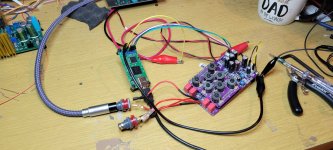Thank you! I’ll try to do this, this weekend. The digital board, I also bought that from you. Would you happen to know if I should ground it as well?
The digital board shares 0V with the DAC so grounding the latter will ground the former too.
@jimk04 Thank you, very helpful. @abraxalito Would it be detrimental if I grounded everything from the Kubelik instead?
Yes, its just the power module which was originally designed for Kubelik (20V) but we repurposed it for Celibidache's 24V. There's a 0V wire between DAC and the power module so no need for additional grounding of that power module.
Sorry, I mean since the Kubelik power module is closer to my chassis’s ground, can I just ground the Kubelik instead of the 0V of the Celibdache?
I also plan on changing the IEC plug since I have a 3d printer and can fabricate a mounting component. A fuse and an on/off switch would be nice. Do you know if it’s ok to ground the transformer directly to the chassis or if it should it be insulated and ground to a star ground? Thanks!
I also plan on changing the IEC plug since I have a 3d printer and can fabricate a mounting component. A fuse and an on/off switch would be nice. Do you know if it’s ok to ground the transformer directly to the chassis or if it should it be insulated and ground to a star ground? Thanks!
Yes, you can do it that way (ground the 0V of the Kubelik power module) if its more convenient. I doubt there's any difference as to where the ground take-off point is.
By 'ground the transformer directly' do you mean the metal frame of the trafo? Or do you mean one of the secondary winding terminals of the trafo? If the former then its fine and recommended, the latter wouldn't be sensible.
By 'ground the transformer directly' do you mean the metal frame of the trafo? Or do you mean one of the secondary winding terminals of the trafo? If the former then its fine and recommended, the latter wouldn't be sensible.
Thank you, I'll ground the Kubelik module. It's the trafo metal frame that is touching the chassis directly. I've heard some insulate it. Thank you for clearing that up!
I can't see the benefit of insulating the trafo frame but open to being shown how its better. To my mind, since there is capacitance to the frame from both the windings, earthing the frame provides a path for leakage currents (including noise) to flow back to mains earth. This has the effect of reducing the coupling between primary and secondary and hence less common-mode noise makes it into the DAC circuitry.
Measurements confirm this.To my mind,
Only, one has to play with the polarity of the mains wires.
The Neutral has to be the one connected to the inner turns of the primary winding (i.e. the turns that are closest to the core).
Shorter loop for leakage current, which also reflects to better sound.
George
That's good to know, thanks George. I do recall Charles Hansen going back quite a few years saying getting the right mains 'polarity' on a trafo was important for SQ.
He was right.
A costless, very effective "tuning".
With equipment having only one mains transformer inside, there is no need to open the lid and check where the Neutral is connected. Turning the plug at the wall receptacle and having a listen to the music for a minute is enough.
I find the change in sound consistently repeatable with every switching of plug's polarity.
The gray area can be with equipment having more than one transformer inside. With those, the primaries of all main's transformers have to be checked for having the same polarity (need to open the hood, check and correct if neccesary). After that , they can be treated as a one-transformer equipment.
George
A costless, very effective "tuning".
With equipment having only one mains transformer inside, there is no need to open the lid and check where the Neutral is connected. Turning the plug at the wall receptacle and having a listen to the music for a minute is enough.
I find the change in sound consistently repeatable with every switching of plug's polarity.
The gray area can be with equipment having more than one transformer inside. With those, the primaries of all main's transformers have to be checked for having the same polarity (need to open the hood, check and correct if neccesary). After that , they can be treated as a one-transformer equipment.
George
PSU @ 24 vdc
TP1 : 19.32
TP2 : 10.1
TP3 : 20.54
TP4 : 2.5
TP5 : 4.9
TP6 : 1.752
TP7 : 10.1
TP8 : 10.1
TP9 : 10.1
TP10 : 10.1
TP11 : 10.1
TP12 : 10
Seem reasonable don't they?
TP1 : 19.32
TP2 : 10.1
TP3 : 20.54
TP4 : 2.5
TP5 : 4.9
TP6 : 1.752
TP7 : 10.1
TP8 : 10.1
TP9 : 10.1
TP10 : 10.1
TP11 : 10.1
TP12 : 10
Seem reasonable don't they?
I tested again today with Amanero. Same behavior. One channel is boiling. Noticed that when I press the two red WIMA output capacitors between then it is fixed but I don't know if it is them or something else. Visual inspections gives me nothing. BTW soldering gun today blew up....
Attachments
- Home
- Vendor's Bazaar
- Celibidache NOS DAC
